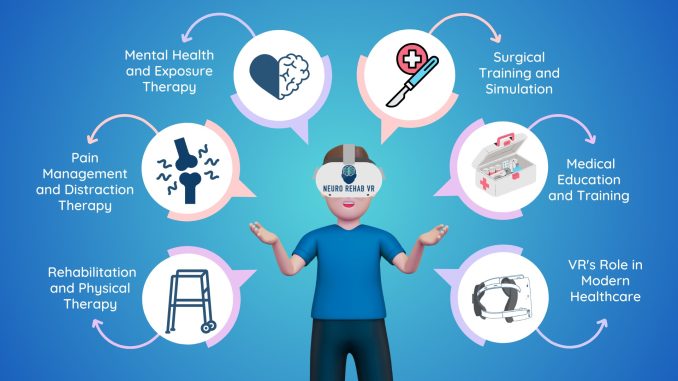
The integration of cutting-edge technology into the venerable fields of healthcare and therapy is continuously pushing the boundaries of what’s possible, and among these innovations, Virtual Reality (VR) stands out as a particularly transformative force. Far from being confined to the realm of gaming and entertainment, VR is rapidly establishing itself as a powerful tool in clinical settings, offering immersive, controlled, and highly customizable environments that are revolutionizing medical training, pain management, mental health treatment, and physical rehabilitation. Its ability to transport users to entirely different realities is proving to be a unique asset in addressing some of the most complex challenges in patient care.
One of the most significant contributions of Virtual Reality to healthcare is its profound impact on medical training and education. Traditionally, aspiring medical professionals rely on textbooks, lectures, and limited hands-on experience with cadavers or mannequins. VR shatters these limitations by offering highly realistic, interactive simulations that allow students and seasoned practitioners alike to hone their skills in a risk-free environment. Imagine a medical student performing a complex surgical procedure repeatedly in a virtual operating room, complete with haptic feedback that mimics the feel of real tissue. They can make mistakes, learn from them instantly, and refine their technique without any risk to a patient. This capability extends beyond surgery to diagnostic training, emergency response simulations, and even practicing patient communication skills. By providing a safe space for repetitive practice and exposure to rare or high-stakes scenarios, VR significantly accelerates skill acquisition, builds confidence, and ultimately contributes to improved patient safety and better clinical outcomes.
Beyond training, VR is demonstrating remarkable efficacy in pain management, particularly for acute and chronic conditions. The core principle here is distraction and immersion. When a patient is immersed in a captivating virtual environment, their brain’s attention resources are diverted away from the painful stimuli. For instance, burn victims undergoing painful wound dressing changes have reported significant reductions in perceived pain when immersed in calming virtual worlds like “SnowWorld,” where they can throw snowballs at virtual characters. This non-pharmacological approach offers a valuable alternative or complement to traditional pain medication, reducing reliance on analgesics and their potential side effects. For chronic pain sufferers, VR can also facilitate exposure to movements that they might otherwise fear due to anticipated pain, helping to retrain the brain’s pain pathways and improve functional mobility in a controlled and psychologically safe setting.
The therapeutic potential of Virtual Reality in mental health and therapy is equally compelling. VR exposure therapy has emerged as a highly effective treatment for phobias, anxiety disorders, and Post-Traumatic Stress Disorder (PTSD). Instead of physically confronting their fears, patients can be gradually exposed to anxiety-inducing situations in a controlled, virtual environment. For someone with a fear of flying, for example, a therapist can guide them through a simulated airport, boarding process, and even a flight, progressively increasing the intensity of the experience. This allows patients to practice coping mechanisms, develop resilience, and habituate to their fears in a safe space where they can pause or exit the simulation at any time. Similarly, VR can create relaxing, calming environments for stress reduction and mindfulness exercises, providing a portable sanctuary for patients to practice coping strategies. Its ability to personalize scenarios and objectively track patient responses makes it a powerful tool for therapists.
In physical rehabilitation, VR transforms what can often be a repetitive and monotonous process into an engaging and even gamified experience. Patients recovering from strokes, injuries, or neurological conditions often need to perform specific exercises to regain motor skills and mobility. VR applications can overlay these exercises with interactive games or challenges, making the therapy more enjoyable and motivating. Imagine a stroke patient needing to repeatedly extend their arm; a VR game might turn this movement into a virtual activity like swatting virtual objects or collecting items in a fantastical world. The real-time feedback provided by VR systems, coupled with the immersive nature of the experience, enhances patient engagement, adherence to therapy regimens, and ultimately, accelerates recovery times.
However, the widespread adoption of VR in healthcare is not without its challenges. The cost of high-quality VR hardware and specialized software can be substantial, making it a significant investment for healthcare providers. There’s also a need for standardized protocols and rigorous clinical trials to further validate the efficacy of various VR interventions across diverse patient populations. Moreover, ensuring data privacy and cybersecurity is paramount, given the sensitive nature of patient information that may be processed by VR systems. Training healthcare professionals to effectively integrate VR into their practice and providing technical support for patients using VR at home are also crucial considerations.
Despite these hurdles, the future of Virtual Reality in healthcare and therapy appears incredibly promising. As VR technology becomes more affordable, accessible, and sophisticated, its applications are expected to expand even further. We may see personalized VR therapies tailored precisely to an individual’s neurophysiology, remote VR-enabled consultations reaching underserved populations, and even VR integrated into smart operating rooms for real-time surgical guidance. The immersive power of VR is not just a technological marvel; it’s a profound therapeutic medium that is enabling healthcare professionals to train more effectively, manage pain more empathetically, and empower patients on their journey to recovery and well-being.